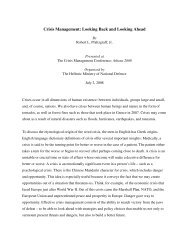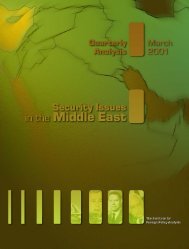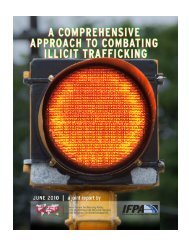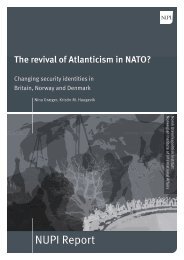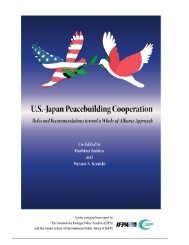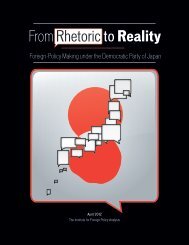Realigning Priorities: The U.S.-Japan Alliance and the Future of ...
Realigning Priorities: The U.S.-Japan Alliance and the Future of ...
Realigning Priorities: The U.S.-Japan Alliance and the Future of ...
Create successful ePaper yourself
Turn your PDF publications into a flip-book with our unique Google optimized e-Paper software.
t h e I n s t i t u t e f o r F o r e i g n P o l i c y A n a ly s i s<br />
<strong>the</strong>mselves, <strong>and</strong> keeping track <strong>of</strong> <strong>the</strong>se <strong>and</strong> o<strong>the</strong>r developments<br />
should help Washington to maintain effective extended<br />
deterrence.<br />
An <strong>of</strong>ten overlooked area <strong>of</strong> <strong>the</strong> extended deterrence issue<br />
is <strong>Japan</strong>’s own technical capacity to produce a nuclear<br />
deterrent, if it decided that such a paradigm shift was necessary.<br />
After all, <strong>the</strong> domestic<br />
legal <strong>and</strong> political barriers to<br />
nuclear weapons development<br />
(or introduction) will be<br />
<strong>the</strong> last to fall if <strong>Japan</strong> ever decided<br />
on such a course. If policy<br />
makers grew more nervous about <strong>the</strong> future <strong>and</strong> wanted<br />
to shorten <strong>the</strong> lead time to developing strategic nuclear<br />
options <strong>of</strong> <strong>the</strong>ir own, <strong>the</strong>y could initiate interim steps under<br />
<strong>the</strong> radar that seek to enhance <strong>Japan</strong>’s domestic industrial<br />
<strong>and</strong> scientific capacity in this area. Though many<br />
<strong>of</strong> <strong>the</strong>se steps would be extremely difficult for outsiders<br />
to recognize, some <strong>of</strong> <strong>the</strong>m might be visible, <strong>and</strong> toge<strong>the</strong>r<br />
with o<strong>the</strong>r telltale signs <strong>of</strong> more active hedging by <strong>Japan</strong>ese<br />
policy makers, Washington can better evaluate what<br />
its ally thinks about <strong>the</strong> future <strong>of</strong> <strong>the</strong> alliance <strong>and</strong> how to<br />
keep it serving both countries’ interests.<br />
49 See, for example, Federation <strong>of</strong> American<br />
Scientists 2000 <strong>and</strong> Kamiya 2002, respectively.<br />
50 <strong>The</strong> U.S. Department <strong>of</strong> Energy’s guidance<br />
on <strong>the</strong> issue <strong>of</strong> using reactor-grade plutonium<br />
in nuclear weapons suggests that an advanced<br />
NWS using modern designs could produce reliable<br />
weapons comparable to those produced<br />
using weapons-grade plutonium (Miller 2002).<br />
Technical <strong>and</strong> scientific capacity<br />
If <strong>the</strong> regional security equation tilts fur<strong>the</strong>r out <strong>of</strong> <strong>Japan</strong>’s<br />
favor, ei<strong>the</strong>r because <strong>of</strong> a demonstrated North Korean<br />
capacity to deliver nuclear weapons on <strong>Japan</strong> or <strong>the</strong> U.S.<br />
mainl<strong>and</strong>, Chinese deployment <strong>of</strong> aircraft carriers, or some<br />
similar development, <strong>Japan</strong>ese policy makers are likely to<br />
respond by taking incremental steps toward enhancing external<br />
<strong>and</strong> internal balancing. If <strong>the</strong> potential for external<br />
balancing seems insufficient or in doubt for some reason,<br />
<strong>the</strong>n internal balancing will take on more importance. Policies<br />
to support internal balancing will be relatively quiet<br />
<strong>and</strong> unobtrusive at first, but <strong>the</strong>y will become increasingly<br />
obvious if <strong>the</strong> situation worsens.<br />
Some change is already noticeable in <strong>the</strong> area <strong>of</strong> defense-related<br />
science <strong>and</strong> technology R&D, but many formal<br />
<strong>and</strong> informal barriers still exist between <strong>the</strong> research<br />
<strong>and</strong> defense communities in <strong>Japan</strong> that retard <strong>the</strong> application<br />
<strong>of</strong> new technologies for national security purposes, especially<br />
anything related to nuclear weapons or <strong>of</strong>fensive<br />
strike systems. But if U.S. policy makers are going to notice<br />
<strong>the</strong>se incremental changes in defense industrial <strong>and</strong><br />
scientific policies, especially in <strong>the</strong> nuclear area, <strong>the</strong>y first<br />
need to establish some sort <strong>of</strong> baseline regarding <strong>Japan</strong>’s<br />
current technical readiness to build a nuclear bomb.<br />
Past studies <strong>of</strong> <strong>Japan</strong>’s nuclear options are remarkable<br />
in <strong>the</strong>ir lack <strong>of</strong> consensus about seemingly concrete details<br />
on this point, with some concluding that <strong>Japan</strong> is technically<br />
capable <strong>of</strong> developing a nuclear weapon within a year<br />
(some even suggest six months or less), while o<strong>the</strong>rs argue<br />
that it would take at least a decade. 49 As early as 1966, a<br />
<strong>the</strong>n-classified U.S. national intelligence estimate concluded<br />
that it would take about two years for <strong>Japan</strong> to produce<br />
<strong>and</strong> test a nuclear weapon, if it could get uranium without<br />
safeguards (National Security Archive 2005). One wonders<br />
what <strong>the</strong> <strong>of</strong>ficial U.S. estimate might be today.<br />
A respected <strong>Japan</strong>ese pr<strong>of</strong>essor <strong>of</strong> nuclear engineering<br />
told a <strong>Japan</strong>ese newspaper that “it takes at least a year to<br />
develop a nuclear bomb, going through <strong>the</strong> whole process<br />
from design, manufacture <strong>and</strong> verification to a detonation<br />
test,” but “several years” if <strong>the</strong> time needed to build a nuclear<br />
reactor ( for producing <strong>the</strong> ideal fuel) <strong>and</strong> related facilities<br />
are included (Daily Yomiuri 2007). As noted earlier,<br />
<strong>the</strong> Sankei Shimbun reported on a secret government-requested<br />
study in 2006 that estimated it would take “at<br />
least 3 to 5 years until <strong>Japan</strong> can go into trial production<br />
<strong>of</strong> a miniaturized warhead” (Tamura 2006).<br />
Most <strong>of</strong> <strong>the</strong>se estimates account for <strong>the</strong> ancillary infrastructure<br />
necessary to build a viable nuclear weapons<br />
program (such as a reliable delivery system or comm<strong>and</strong><br />
<strong>and</strong> control), but <strong>the</strong>y are still artificial because <strong>the</strong>y do<br />
not account for <strong>the</strong> domestic legal <strong>and</strong> political obstacles<br />
that must be overcome. Even with such caveats, however,<br />
we have found nothing to suggest that <strong>Japan</strong> could develop<br />
a safe <strong>and</strong> functioning nuclear deterrent in less than<br />
one year, but within two years is ano<strong>the</strong>r story.<br />
Those who claim that <strong>Japan</strong> could build a nuclear arsenal<br />
relatively easily point first to <strong>the</strong> country’s large civilian<br />
nuclear energy program, <strong>the</strong> self-contained nature<br />
<strong>of</strong> its nuclear fuel cycle (including uranium enrichment<br />
<strong>and</strong> fuel reprocessing capability), <strong>and</strong> its growing stockpile<br />
<strong>of</strong> plutonium (over 40 tons). Even though <strong>Japan</strong>’s stock <strong>of</strong><br />
plutonium is reactor grade, which is less easily converted<br />
for use in nuclear weapons, it none<strong>the</strong>less can be used for<br />
weapons, <strong>and</strong> this would provide <strong>Japan</strong> with <strong>the</strong> raw materials<br />
for hundreds <strong>of</strong> nuclear warheads. 50 <strong>Japan</strong>’s newest<br />
nuclear reprocessing plant (Rokkasho) produced its first<br />
test batch <strong>of</strong> fuel (a uranium-plutonium mixture known as<br />
44<br />
<strong>The</strong> U.S.-<strong>Japan</strong> <strong>Alliance</strong> <strong>and</strong> <strong>the</strong> <strong>Future</strong> <strong>of</strong> Extended Deterrence





